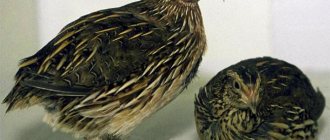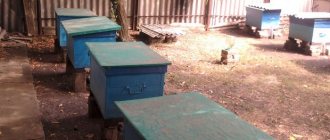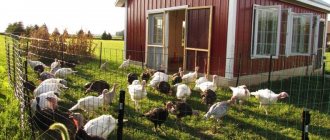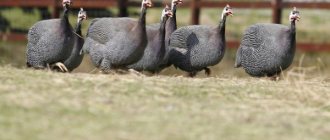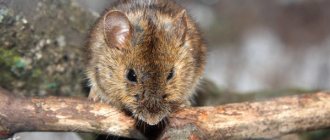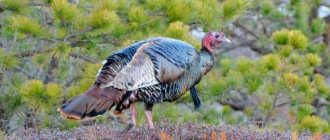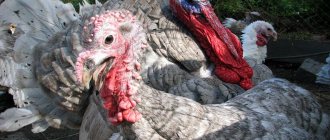Raising turkey poults at home for beginners
Before purchasing young turkeys, you need to familiarize yourself with all the nuances of their maintenance and feeding, as well as prepare cages and equipment. In addition to quality food, you will have to take care of disease prevention and purchase a first aid kit with the necessary medications.
Which breeds are best suited
It is better to start raising turkey poults at home with light and medium-heavy breeds. Super heavy modern hybrids are extremely difficult for a beginner to grow. For these crosses, it is necessary to create conditions with a constant temperature and balanced feeding, and to ensure sterility in the early stages of cultivation. Organizing all this on a small home farm is difficult.
The following varieties are suitable for breeding on private farms:
- Tikhoretskaya black. A domestic breed of turkeys, adapted for fattening on pastures. A medium-sized, but unpretentious and strong bird. The weight of adult males reaches 10 kg, females are twice as light. Young animals are slaughtered at the age of 5–6 months, producing a carcass of 4 kg. Turkeys lay up to 80 eggs a year and are good brood hens.
- Bronze broad-chested. An American breed of bird, distinguished by its large and fleshy breast. The weight of turkeys is 15–18 kg, females are about 10 kg. Egg production of turkeys is up to 120 eggs. Representatives of the breed need a warm place in winter and are not suitable for grazing. But turkeys grow quickly (they are slaughtered for meat at the age of 4 months) and have strong immunity.
- White Moscow. A medium-heavy breed adapted to domestic climatic conditions. The weight of males is 15 kg, females - 8 kg. Slaughter weight of 4.5 kg is reached at 5 months. Turkeys lay about a hundred eggs, the hatchability of chicks is close to 90%.
- Big 9. One of the few turkey crosses that is distinguished by its endurance and “forgives” a beginner some mistakes in growing. The hybrid was obtained in England, but adapts well to Russian climatic conditions. The weight of turkeys is 17–19 kg, and that of turkeys is 8–10 kg. Slaughter age is reached at the age of four months. In a year, 100–120 eggs can be collected from a female, but the offspring of the hybrid may not have the productivity of their parents.
When purchasing young animals for fattening, you should give preference to turkey poults purchased from poultry farms and large incubators, bypassing intermediaries.
Tikhoretskaya black
Bronze broad-breasted
White Moscow
Big 9
Methods of raising turkeys
Raising turkey poults can be done in several ways:
- keep young animals from birth to slaughter indoors - first in brooders and then transferred to cages;
- fatten turkey poults on pasture;
- combine both methods, keeping the young animals in a cage for up to 3 months, and then releasing them to pasture.
The growing method is chosen by the poultry farmer based on his own conditions. Pasturing turkey poults is the most profitable, but is only suitable for small breeds. In addition, not every pasture can be used for this bird.
Keeping young animals indoors is more expensive, but allows the farmer to fully control the conditions in which the chicks are located and protect them from infections.
Possible difficulties
The most difficult period in raising chicks is from birth to 3–4 months. At this time, babies have imperfect immunity and are susceptible to colds and infections. For active growth, turkey poults must be provided with food rich in protein and vitamins.
The cause of early death of chicks can be:
- dampness, drafts in the room, low temperature in the turkey house;
- insufficient ventilation, due to which the bird develops oxygen starvation;
- viruses and infections due to contact of turkey poults with wild birds or their droppings;
- unbalanced diet.
When young animals are released to pasture, when the dew has not cleared, turkey poults often catch a cold and fall down on their feet.
The main requirement for a room for keeping turkeys is warmth and dryness.
Arrangement of a walking area for turkeys
Part of the territory must be covered from above. The canopy will provide shelter for turkeys in the summer heat. It is advisable that the walking area have a green clearing with grass, then breeding will become easier both for beginning farmers and for the individuals themselves. You can even specially plant forage crops such as oats, clover, and alfalfa in the spring. Don't forget about water, especially in summer. It should be fresh and change every day. If the water often gets dirty, then it needs to be changed more often than not.
Feeders should also be placed on the site. It is better to put food there that will not spoil soon, such as oats or barley. The bird needs to walk not only in the summer, but also in the cold season. However, it is worth remembering that when the frost is over 10 degrees, it is better for the bird to stay at home to avoid colds, hypothermia and frostbite. It is best that when walking, turkeys do not step on snow, but on straw, otherwise they may freeze their feet. Walking is necessary for such active birds, or their muscles will be too weak and the meat too fatty.
Many experienced breeders recommend that novice farmers keep females and males separately. It is believed that this way males are less aggressive. With this type of housing, one male at a time is allowed into the house with the females. However, it is permissible to keep birds of different sexes together. It is worth considering that one turkey can fertilize no more than 5 turkeys. So there should be 5 times more females than males. If there are too many birds for one poultry house, then it is better to divide the turkeys into several families.
Rules and features of cultivation
Keeping turkey poults is possible only in a new room or in a room that has been thoroughly disinfected after the previous batch of poultry. The sanitary gap must be at least 40 days. After the previous batch of turkeys, all bedding is removed from the room and the floors, walls and ceiling are washed with special products. Whitewash the walls with lime if they are wooden or stone. The cells are burned with a blowtorch.
In the room for turkeys, they build strong perches or install wide boards if the bird’s weight is large. Feeders should be such that all the livestock can be accommodated near them at the same time. Nipple or vacuum drinkers are used so that the water in them is not contaminated with bedding particles or feed.
The room is provided with heating and lighting. The optimal temperature for raising turkey poults is from +33 ℃ (at birth) to +20 ℃ (in adolescence). Lights for babies in the first days of life should be on around the clock.
Turkey poults are kept separately from other types of poultry, since their immunity is weaker than that of chickens or guinea fowl. You can combine turkeys for walking with land-based poultry species at 3–4 months, when the young animals are stronger.
Little trick
Turkeys often suffer from parasites in their feathers from careless owners in winter. To avoid this misfortune, be sure to leave a container filled with ash and sand in the house. Poultry uses a sand-ash bath to prevent and control parasites.
Don't forget that turkeys, like chickens, constantly peck at small gravel and pebbles. Separately from the food, pour crushed shells, chalk and charcoal into the trough. This is necessary for digestion.
There is nothing particularly difficult about keeping turkeys in winter. If the owner is not lazy and prepares for low temperatures and short days, then his poultry house will overwinter in warmth and comfort, without losses.
How to care for turkey poults
Cleanliness, dryness and warmth - these are the main rules for raising turkey poults from scratch. From birth, babies differ little in behavior from ordinary chickens; in comfortable conditions, they grow well and gain weight.
Caring for newborn chicks
Turkey chicks are removed from the incubator when their down is almost dry. The babies are placed in a brooder, where the temperature is maintained at 33–35 degrees. It is convenient to use an IR lamp as a source of light and heat, hanging it not in the center of the box, but moving it to one corner. In the corner opposite the lamp, the temperature will be 2–4 degrees cooler than under the lamp. This will allow the chicks to move to a cooler place on their own if it gets hot under the light bulb.
As bedding for turkey poults, disposable diapers or cloths are placed in the brooder. The paper is too slippery for babies, their paws will move apart and there is a risk of the appearance of “splits” - chicks with their paws stretched to the sides.
Daily turkey poults
About a day after hatching, the young begin to become interested in food and water. Drinkers are placed in the brooder and the chicks are forced to dip their beaks into the water. It is better to pour the first portions of food directly onto the floor so that the turkey poults can see it clearly.
Diapers continue to be used as bedding until 5–7 days of age. The babies are then transferred to cages on a mesh floor or fine wood shavings or bran are used as bedding.
How to care for older chicks
Caring for and feeding grown turkey poults at home is no more difficult than raising chickens. With the intensive fattening method, adolescents are kept in spacious cages (each bird must have at least 40 sq. cm of floor space) or released onto the floor in a barn.
When keeping birds in cages, the room temperature should not fall below +20 degrees. The lights are on from 8 a.m. to 8 p.m.
If there is a large number of birds in the turkey poultry, forced ventilation should work.
From 3–4 months of age, young animals can be released onto pasture, where turkey poults graze, eating grass and insects. You should make sure that the meadow is not swampy and there are no poisonous plants. Fresh air, sun and active exercise significantly strengthen the bird’s immunity.
Breeding
In November, young animals are selected for turkey breeding in a ratio of 5–7 females per 1 male. Males are replaced every 5 years. The rut begins at the end of February and beginning of March. Before the start of the mating season, males have their claws trimmed. With an extended laying period from March to September, the peak egg production of turkeys occurs from May to July.
Improving egg quality
The viability of the embryo can be increased by irradiating the eggs under a mercury-quartz lamp, which is placed at a height of 40 cm. The procedure lasts 2–30 minutes.
Sorting and storage
The eggs are taken from the hen while they are still warm and stored in a cool, dry room.
Rules for collecting and sorting eggs:
- Eggs laid before 8 a.m. are taken for incubation;
- regular oval shape, weighing 80–90 g;
- with a uniformly translucent shell, with a dark yolk located in the center;
- with white without spots.
Eggs are stored at 12° C, relative air humidity 60–70% in a horizontal position. Turn over periodically.
Incubation
In a separate room, nests for incubation measuring 80x80x50 cm are installed. 14–15 eggs are placed under the hen. The temperature in the room during incubation is from 15 to 20º C. The turkey is fed ad libitum. The hen may not leave the nest for days - in this case she is force-fed. The feathers on the turkey's belly are plucked and the nest is covered with them.
The hatching of turkey poults occurs on days 27–28. Sometimes turkey chicks are hatched by a brood hen of the meat and egg breed, under which 9–11 eggs are placed in warm weather and 7–9 in cold weather.
Use of incubators
Incubation begins in early April. Warm eggs are placed horizontally in trays.
Incubation mode:
- from days 1 to 5, the temperature is maintained at 37.8–38° C;
- 6–12 days – 37.6–37.8° C;
- 13–25 days – 37.5–37.6º C;
- on the 26th day – 37.2º C;
- on the 27th – 37.2–37º C;
- on the 28th – 37º C.
The incubator must be equipped with good ventilation. From days 1 to 15, ventilation is weak, temperature and humidity are high. In homemade incubators, eggs are turned by hand twice a day.
How to raise turkey poults
Below are the basic conditions for successfully raising young turkeys. The farmer will have to work hard to ensure the desired temperature and daylight hours. But if you follow all the rules, you will be able to get good weight gain and maintain the health of the herd.
Temperature
From the first to the fifth day, the temperature in the brooder is maintained at 33–35 degrees. By the 12th day it is gradually reduced to 25 ℃. Month-old turkey poults are kept at a temperature of +23 degrees.
Lighting
From the first to the seventh day of a turkey chick’s life, the light in the brooder should be on around the clock. Chicks do not need bright light. Enough light from an IR lamp or an incandescent lamp with a power of 40 W per 2 square meters. m floor area.
From the age of one week they begin to turn off the lights at night.
The duration of dark time is 3–4 hours, gradually increasing it to 12 hours by 2 months of the chick’s life.
Sanitary conditions
The stocking density of young animals aged from 0 to 2 weeks is 10 animals per 50–70 sq. m. cm. Next, the bird needs more area - at least 40 cm2 per individual. With more crowded housing, the risk of chicks pecking at each other increases.
The brooder is cleaned daily, changing diapers or cloths. For older chicks, the bedding is changed as it gets dirty, but a clean layer is added daily. When keeping cages, the trays under the cages are cleaned 2 times a week.
Drinkers and feeders for wet mash are washed daily, containers for dry food - once a week.
Proper care
The bird house and grazing area should be kept clean. It is necessary to carry out disinfection measures and treatment with insecticides three times a month. A thorough examination of each member of the flock is intended to protect the livestock from infection.
It is necessary to change the water in drinking bowls and wash them twice a week. Make sure that droppings do not get into the food. Compliance with these standards will help prevent deadly epidemics.
Methods of content
The choice of method for keeping turkey poults depends on the specific conditions of the farm:
- poultry population;
- farm location (not everywhere there are free and clean pastures);
- turkey breeds;
- cultivation purposes.
To obtain quick meat, an intensive method is used: the poultry is kept indoors and fed with balanced factory feed. To breed turkeys on the farm for your own needs and raise breeding young animals, it is advisable to give the bird the opportunity to be in the fresh air and move a lot.
Cages and brooders
Brooders for young animals are made of plywood, but it is better to use polycarbonate or plastic - it is easier to clean and more durable. The following dimensions are convenient for servicing the brooder: width - 70–90 cm, height - 50 cm, length - 150 cm. The box is installed on legs so that it is convenient to clean and take turkey poults by opening the lid on top.
Ventilation holes are provided in the walls of the brooder. Light bulbs are installed in the lid for lighting and heating.
Often the brooder is equipped with a retractable tray for easy cleaning.
Cages for older turkeys are made of stainless steel or galvanized mesh, with a cell size of 8 by 12 mm. To prevent a heavy bird from injuring its paws on the metal on the floor, a plastic mesh is laid on top of the metal mesh.
On unlimited walks
If the weather is favorable (dry and warm), turkeys from 8 weeks of age can be kept outside around the clock. The pasture must be dry. Walking poultry in wetlands and along the banks of lakes or rivers risks infecting turkey poults with worms.
For the birds, a temporary enclosure is fenced off with mesh and a simple canopy from the sun is installed. Water and food are placed inside the pen. The area of the pen is 2 square meters. m per 1 individual.
As the poults eat most of the vegetation inside the pen, it is moved to a new area. This method allows you to evenly remove vegetation in the meadow.
If the natural grass of the meadow is poor, you can sow clover, sainfoin, alfalfa, and oats specifically for the birds.
Floor content
It is considered less traumatic for the bird’s paws and may be the only option for keeping heavy breed turkeys.
The room must be kept clean and dry by regularly changing the bedding. In addition to shavings, bran, dried peat, and straw cuttings are used.
Hay, due to the likelihood of mold spores remaining on the blades of grass, is not used.
On mesh floors
It is more convenient for the poultry farmer to clean the turkey barn by cleaning the trays under the cages than to clean the entire barn. Litter is also not required for this type of maintenance.
It is necessary to monitor the condition of the soles of the feet of turkey poults. If wounds and sores have formed on them, the birds are transferred to solid floors.
Room for adult birds
For an adult turkey, prepare a dry room without drafts or dampness. The area is calculated depending on the breed of bird and the weight of the male.
On average, for comfortable living you will need 1.5 square meters per two heads of turkeys.
Rules for the arrangement of premises and conditions for keeping turkeys:
- All turkeys need perches assembled from wooden slats with a cross-section of 6*10 cm (the large size of adult individuals is taken into account).
- The slats are rounded along the upper contour and must be sanded to remove all gaps and cracks.
- For one bird you will need 50-60 cm of perch length.
- All turkeys are birds with a complex, quarrelsome disposition, so it is quite difficult to organize keeping turkeys in a cage.
- Dry bedding, such as straw, should be spread around the entire perimeter. Regular cleaning and replacement of old hay or straw is essential to prevent mold growth.
- Separate from the main area, nests for laying eggs are built. As a rule, the wearing period occurs at the end of February - beginning of March. During this period, you should increase the daylight hours for the bird, turning on the lamp in the morning and evening.
- The nests should be located against the far wall, in a quiet place, without signs of dampness. The best solution is to install two-tier crates, since turkeys like to sit at heights.
- For full development, the bird needs regular walks, where turkeys can eat fresh greens. For walking, a hole with a door of sufficient size is made in one wall.
- It is important for novice farmers to know how turkeys are kept in winter. An adult bird can withstand significant frosts, however, it will not tolerate dampness at all.
It is important to organize high-quality ventilation in the selected room, since stale air contributes to the spread of infectious agents. To avoid drafts, install a classic supply and exhaust system at a sufficient level from the floor.
What to feed turkey poults from the first days of life
On the eve of the hatching of the chicks or the purchase of young animals, it is necessary to prepare food for the babies. This can be ready-made factory compound feed for turkey poults or food made independently: boiled eggs, cereals, cottage cheese, greens.
First meal
Insects serve as the first food for turkeys in the wild. The chicks deftly hunt for insects, ants and larvae. Such food, rich in protein, helps to quickly satiate the baby.
Feeding a day old chick
An analogue of a natural diet for turkey poults at home would be a boiled egg. You can use eggs from any bird, boiling them for at least 7 minutes. The egg is peeled and finely chopped, sprinkled with corn grits so that the pieces do not stick together.
The egg is poured directly onto the floor of the brooder, with a bright cloth laid down for this. On a green, blue or red background, turkey poults can clearly see light pieces, and they readily peck them. This food is given to babies little by little, since eggs in a brooder at a temperature of +33 degrees quickly deteriorate.
Feeding turkey poults with eggs continues for up to 5 days, giving food 5-6 times a day.
Starter feed is given to young animals in dry form, poured once a day, ad libitum.
Feeding week-old turkey poults
At this age, eggs are excluded from the diet, cottage cheese, finely crushed grains and greens are introduced into the menu. An approximate daily diet for a week-old turkey looks like this:
- grain mixture or cereals (corn, wheat) - 12 g;
- cottage cheese - 7–9 g;
- dandelion greens, green onions, quinoa, clover - 10 g;
- grated carrots or pumpkin - 9 g;
- feed yeast - 0.5 g;
- fish meal - 1 g;
- shell rock - 0.3 g.
The products are given in the form of a crumbly semi-dry mash.
What to feed turkey poults per month
Feeding one-month-old turkey poults continues in a similar pattern, increasing the amount of feed. The mash includes crushed barley, whey or skimmed milk. Dairy products can be replaced with meat or fish broth.
Per day for a 30-day-old chick you will need:
- 40 g grain mixture;
- 20–30 g of greens;
- 15 g carrots or pumpkin;
- 5 g cottage cheese;
- 10 g meat and bone meal;
- 1 g feed yeast;
- 2 g chalk or shell rock;
- 0.5 g salt.
They feed with mash at least 4 times a day, thoroughly washing the feeders after each feeding.
If poultry is fattened using mixed feed, at this age the turkey poults are given the “Growth” mixture.
Diet of three-month turkey poults
Young animals are kept on a high-calorie diet with a protein content of at least 18% for up to 4 months. This is achieved by adding cake or meal, feed yeast, fish or meat and bone meal, and cooked meat waste to the feed.
The daily diet of a turkey at the age of 100 days looks like this:
- grain mixture - 100 g;
- sunflower cake - 15 g;
- green legumes - 80 g;
- carrots, pumpkin, fodder beets - 60 g;
- boiled potatoes - 60 g;
- fish meal - 8 g;
- feed yeast - 5 g;
- chalk, shell - 2 g;
- salt - 0.8 g.
Young animals fed with complete feed are transferred to the Finish mixture for the final stage of fattening. They give plenty of food.
First food
Newborn turkey chicks do not have a swallowing reflex, so they often refuse the offered food. On the first day, the only suitable food for the chicks is boiled eggs with herbs, low-fat cottage cheese, and boiled water with a small amount of sugar.
At the age of one week, owners exclude boiled eggs from the diet and gradually begin to accustom the chicks to other foods. To do this, you can use chopped green onions, scatter them on plywood or cardboard in the brooder, and tap the material with your fingers to attract the birds' attention. In addition, newborn turkey chicks eat boiled porridge with eggs, herbs and boiled carrots well.
The chicks have to be fed almost every 3 hours, giving food in small portions. As turkeys grow older, the amount of feed and the breaks between feedings increase.
The porridge that turkey poults will eat should be crumbly and not sticky, since the chicks’ digestive system is poorly developed, and sticky porridge can cause serious digestive upset.
What to consider when feeding
Turkeys love brightly colored food and peck the yellow and green bits out of the mash first. To ensure that the mixture is eaten completely, the greens are cut as finely as possible, and the grain is turned into cereal with a particle size of 1 mm.
The bird is fed mash several times a day to prevent it from becoming sour. Turkey poults should eat the offered food within an hour. Remains should be removed. Dry feed should be kept in the feeder at all times.
When feeding your own mixtures, you need to add a premix for broilers to the grain mixture or add complex vitamins to the water.
For breeding turkeys, like other poultry, three main types of feeding are used.
- The dry type of feeding is the simplest, since it does not require the preparation and distribution of the required amount of mash. In order to adhere to the dry type of feeding, it is necessary to purchase feed that is specially made for turkeys of a certain breed.
- The wet type of feeding is the provision of wet mash to birds, the basis of which is ground grain, cake, root vegetables, green feed and animal products. If the farm adheres to the wet type of feeding, the turkeys’ diet must be supplemented with whole grains or cereal waste.
- The combined type of feeding is a diet that consists of three-quarters of wet mash, and is supplemented with skim milk, food waste, vitamin and succulent feed, which must be mixed into the main food and given to the birds at a certain time of day. If one of the elements is missing, it must be gradually replaced by another.
When feeding turkeys, it is important to provide them with gravel. This is necessary for turkeys due to the fact that they have no teeth and they grind all the food they swallow in their muscular stomach. If there is no gravel in the diet of turkeys, then the feed that gets into the digestive tract will be worse digested and absorbed by the bird’s body.
It is best to choose quartzite gravel, which is not destroyed by the acidic environment of the stomach. Young turkeys should be given finer gravel (no more than two millimeters in diameter). Gravel cannot be replaced with sand or crushed glass, since glass can damage the mucous membrane of the digestive organs, and sand can clog the bird's intestines.
How to water turkey poults from 0 to 4 months
It is recommended to feed day-old young animals with boiled water, adding glucose (0.5 ml per 1 liter of water) or honey (0.5 teaspoon per liter). From the second day you can use raw but filtered water.
The water should be clean and cool. Access to water is free.
You can use both nipple and vacuum (a jar with a special lid) drinkers.
Not only vitamins are added to the water for turkey poults, but also antibiotics and anthelmintic drugs to prevent the development of diseases. At home, it is recommended to do several drinking sessions:
- from 3 to 8 days - Baytril or Enroflon (0.5 ml per 1 liter of water);
- from 9 to 14 days - Chiktonik or Tetrahydrovit, Vetom according to the instructions;
- from 21 to 28 days - Baycox or Solikox (for coccidiosis);
- from 29 to 34 days - vitamins;
- from 40 to 50 days - Metronidazole (2 tablets per 1 liter of water);
- from 51 to 56 days - vitamins, Vetom.
Such prevention will help avoid the occurrence of infections in the herd.
Baytril
Enroflon
Chiktonik
Baycox
Metronidazole
Vetom
Beautiful mothers
Turkeys are very responsible and caring mothers. Poultry keepers can freely use them to hatch young animals without using incubators. With their help, owners save not only money, but also their energy.
The female sometimes even forgets to eat, so she gets involved in incubating the eggs. The poultry house’s task is to monitor this process; nutrition should be regular.
Periodically remove the hen from the nest so that she can eat and drink water.
Often, other people's eggs are placed under turkeys: chicken, duck, etc. All will be wrapped in care and patiently hatched. One individual raises several dozen turkey poults; turkeys can also take care of the offspring.
Advice from experienced trailer operators
The main mistakes in keeping turkeys are due to the fact that the owner does not take into account the weak immunity and general health of the bird. Experienced farmers give the following advice:
- For the first 3–5 days of life, turkey chicks feed food on a soft cloth , since the chick’s beak is soft. It can damage it by hitting it on a hard surface.
- Children should be protected from stress. Frightened turkey chicks rush around the cage, crushing each other. Talking kindly to them while feeding and cleaning calms the bird.
- The paws of turkey poults should be kept warm until they go out to pasture. Babies are susceptible to colds. The bird should be taken out for a walk after the dew has dried.
- When trying to raise turkey poults without using antibiotics, you should add a lot of green onions (a natural antibiotic) and garlic arrows to the feed . Infusion of wormwood, tansy, and chamomile is poured into the water.
Raising turkey poults is a troublesome, but profitable business. With proper organization of the farm and compliance with feeding rules, it will be possible to obtain a lot of dietary meat. It is better for beginners to start with breeding light and medium crosses, as they have stronger immunity and are less demanding in nutrition.
Diet of young animals
The daily amount of food for feeding young animals depends on the age group of turkey poults.
Required ingredients for nutrition are:
- A boiled chicken egg, which is mixed with the main food.
- Bran.
- Finely crushed grain, millet, wheat.
- As the birds grow older, ground meat and bone meal and fish meal are added to the dry feed.
- Starting from 15 days of age, feed mixed with fermented milk products begins to be introduced.
- Salt and herbs are irreplaceable sources of vitamins, micro- and macroelements for poultry.
The diet should also contain crushed shell rock and chalk (to replenish the body’s daily need for calcium).
